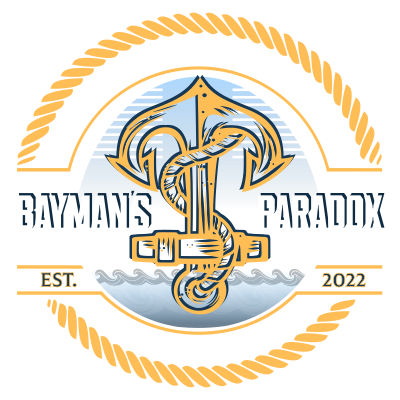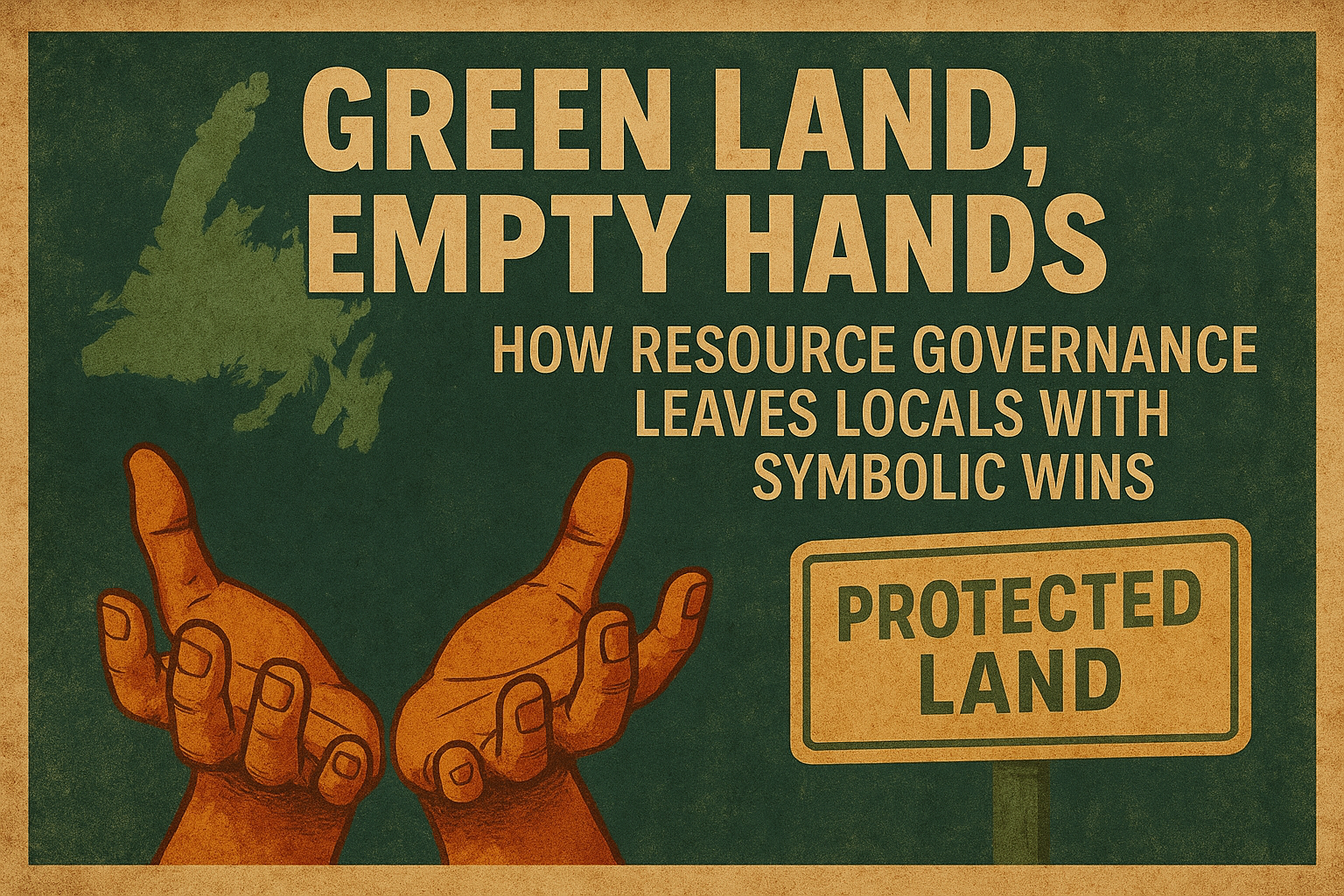The story always begins with a ceremony. A podium in front of a painted backdrop, officials lined up for the photo, words like protection, heritage, sustainability repeated until they lose their shape. The cameras click, the crowd claps. Newfoundland is told it has “won.”
But the win is made of paper and optics. The real decisions—the contracts, the financing, the control over land and resource flows—have already been parceled out elsewhere. The locals are left with recognition and ritual, while the substance has slipped away.
Optics as Governance
Symbolic protections are now a central part of how Newfoundland is governed. A park designation, a conservation label, a UNESCO listing, even the branding of a community as “heritage” — each of these signals care, stewardship, and pride. But as the Local Paradox research notes, such gestures are often “ritualized performances,” staged to generate legitimacy without shifting actual power¹. Protection becomes a banner, not a barrier.
Heritage branding follows the same script. The language of identity and belonging is deployed to mask the material transfer of control. Land, fisheries, and now wind and hydrogen are turned into currency in global agendas. The community is granted a plaque, but not a stake.
Gros Morne: Prestige and Restriction
Consider Gros Morne, inscribed as a UNESCO World Heritage Site in 1987. For the province, it was a global prestige moment: Newfoundland placed on the cultural map of the world. For local residents, it was more complicated. Land-use restrictions tightened, traditional practices faced new oversight, and larger-scale tourism opportunities tended to flow to operators with outside capital rather than to the small family businesses that had long carried the region.
The creation of the park also meant relocation. My own husband’s family was moved out of Sally’s Cove to Cow Head when Gros Morne National Park was formed — a story repeated across the coast as communities were shifted to make way for conservation boundaries. The official narrative celebrated preservation; the lived reality for many was dislocation.
And this was not the first displacement. Newfoundland has a long history of resettlement programs, where whole villages were uprooted in the name of modernization and efficiency. My own mother was affected by that policy. It was not only an economic project but, in places like the French Shore, a cultural one: resettlement disproportionately hit French-Newfoundland communities, continuing a longer pattern of dispersal.
The “win” was real in symbolic terms—international recognition of unique geology and landscape—but the material gains largely flowed outward. The paradox was set: the land is celebrated, but the hands that tended it remain empty³.
Fisheries: Custodians Without Control
The fisheries tell the same story in older form. Ottawa’s language of “custodial management” promised Newfoundlanders a measure of dignity after the cod moratorium. Yet in practice, quotas and access were negotiated internationally, often in ways that prioritized trade leverage over local survival. Communities were framed as heritage stewards—keepers of culture and tradition—while the real levers of stock management and allocation sat in federal or foreign hands²⁴.
The optics were of guardianship. The reality was dispossession.
Wind and Hydrogen: The New Theatre
Fast forward to the present. The province announces massive wind-to-hydrogen projects, pitched as Newfoundland’s contribution to global climate goals. The images are sleek: green energy, future-proof jobs, a place on the world stage. Consultation meetings are held, PowerPoints displayed, and residents told their voices matter¹.
But as the Local Paradox framework makes clear, consultation in Newfoundland often functions as theatre. By the time the chairs are set up and the microphones plugged in, the outcome has already been shaped. The contracts have been drafted, the financing secured, and the strategic buyers identified in Europe. Locals may be promised jobs or community benefits, but the commanding heights—export revenues, ownership stakes, long-term policy leverage—belong to actors far beyond the peninsula¹⁷.
Meanwhile, federal support flows to these megaprojects: Ottawa pledged $128 million to Project Nujio’qonik in Stephenville, while critics on the ground point to ecological risks and community exclusion⁸. Residents have demanded public hearings, arguing that the projects are being fast-tracked without adequate local say⁷.
Again, the land is celebrated as “green.” Again, the locals are applauded for participating. Again, the hands are left empty.
Municipal Dependency: The Soft Budget Trap
Even at the most local level, the same structure persists. A recent economic study of Newfoundland’s “soft budget constraints” shows how municipalities, with weak tax bases and high service costs, rely on provincial bailouts to survive⁵. Transfers and rescues are structured as rituals: announced with gravity, delivered as if they were gifts, then used to reinforce the idea that local autonomy is intact.
But as the mechanism design shows, these bailouts do not empower communities. They keep them solvent but dependent, unable to accumulate the financial base needed to break free. Autonomy is simulated; dependency is reinforced. The optics of resilience mask the fact that municipalities remain tethered to provincial discretion⁵⁶⁹.
Why Symbolic Wins Persist
Symbolic victories are not accidents. They are cheap to deliver and politically effective.
- For governments, recognition costs little. It allows leaders to project stewardship without redistributing real control or revenue.
- For corporations, symbolic protections create the optics of consent. A community brand or heritage label makes projects appear locally anchored, even when profits are exported.
- For the broader public, symbolism offers pride and distraction. People can point to a UNESCO plaque or a “protected” bay as evidence of dignity restored, even as the economic terms worsen.
This system of governance is built on appearances. It delivers applause at the podium while protecting the channels of resource extraction and revenue capture.
The Cost of Empty Hands
The price of this system is borne by communities. Jobs promised but not secured. Contracts advertised but steered to firms with outside capital. Land use decisions framed as consultation but decided elsewhere. A cycle of disillusionment follows, as locals realize their celebrated “wins” change little in their lived conditions.
Dependency deepens, trust erodes, and the sense of dispossession grows sharper. What remains is the paradox: pride without power, heritage without control, protection without prosperity.
Closing the Curtain
The green remains. The landscapes, the parks, the plaques, the heritage declarations—all intact. But the hands are still empty.
Breaking this cycle will require more than another round of symbolic recognition. It will mean demanding material control: real decision-making authority, revenue-sharing, and ownership stakes that anchor communities rather than decorate them. Until then, resource politics in Newfoundland will continue to hand out optics while withholding substance—applause at the curtain call, while the real deals are signed backstage.
See also:
- Tourism Not Toxins: How Garden Hill’s Scar Became the Next Spin of the Carousel
- Factional Mirrors: How Polarization and Patronage Keep Newfoundland Stuck
- Credentialed Silence: How Professional Status Polices Opinion in Newfoundland
- The Faux Consultation Files: Staged Democracy in Newfoundland
References
[1] Van Assche, K., Greenwood, R., & Gruezmacher, M. (2022). The local paradox in grand policy schemes: Lessons from Newfoundland and Labrador. Scandinavian Journal of Management, 38(4), 101212. https://doi.org/10.1016/j.scaman.2022.101212 (Local Download)
[2] Bavington, D. (2011). Managed Annihilation: An Unnatural History of the Newfoundland Cod Collapse. UBC Press. https://www.ubcpress.ca/managed-annihilation
[3] Parks Canada. (2019). Gros Morne National Park of Canada Management Plan. https://parks.canada.ca/pn-np/nl/grosmorne/info/plan/gestion-management-2019
[4] Davis, A., & Korneski, K. (2012). Inshore fisheries after the moratorium. In Stoddart, Catano & Ramos (eds.), Coastal Communities in Transition.
(No open online version found; available via academic libraries. Related material: “The Newfoundland Fishery: Ten Years after the Moratorium” on ResearchGate: https://www.researchgate.net/publication/46488307_The_Newfoundland_Fishery_Ten_Years_after_the_Moratorium)
[5] Guo, X. (2025). Optimal Transfer Mechanism for Municipal Soft-Budget Constraints in Newfoundland. https://arxiv.org/abs/2508.02171v3
[6] Kornai, J. (1986). The soft budget constraint. Kyklos, 39(1), 3–30. https://doi.org/10.1111/j.1467-6435.1986.tb01252.x
[7] Brake, J. (2024, January 16). Residents call for public hearings on controversial wind-to-hydrogen project. The Independent (NL). https://theindependent.ca/news/residents-call-for-public-hearings-on-controversial-wind-to-hydrogen-project/
[8] Government of Canada. (2024, February 28). Canada announces support for new green hydrogen project in Newfoundland and Labrador. Global Affairs Canada. https://www.canada.ca/en/global-affairs/news/2024/02/canada-announces-support-for-new-green-hydrogen-project-in-newfoundland-and-labrador.html
[9] ArXiv. (2025). On the structural weaknesses of Newfoundland municipalities and provincial bailouts. https://arxiv.org/abs/2508.02171

